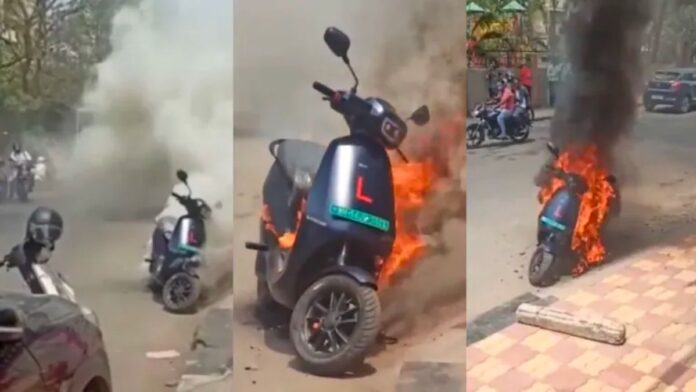Earlier today, an Ola electric scooter caught fire in Pune. Multiple videos have surfaced of a blue S1 electric scooter (it’s unclear whether this is the basic S1 or S1 Pro) stopped on the side of the road with thick white smoke billowing from beneath the bodywork before bursting into flames. Ola claims to be in contact with the scooter’s owner, who is claimed to be in good health. (Xanax)
This is far not the first electric scooter to catch fire in India, but it is without a doubt the most visible. While it is too early to say for sure what caused the heavy smoke and where it was coming from on the scooter, the type of the thick smoke and the place on the scooter from which it was coming suggests that the scooter’s Li-ion battery pack may have experienced thermal runaway.
Why The Battery Catch Fire
This is a well-known phenomenon with such battery packs, in which the internal temperature and pressure of the battery rises faster than it can be dissipated due to overheating. Electrical shorting, quick discharge, overcharging, using the improper charger, poor design, or insufficient cooling are all possible causes of overheating. In this video, the scooter does not appear to be hooked in for charging.
This behavior is harmful because if one battery cell enters thermal runaway, it generates enough heat to induce neighboring battery cells to enter thermal runaway as well. As each battery cell ruptures and discharges its contents, the result is a fire that bursts up repeatedly. These types of flames can be extremely difficult to put out, especially in a single person’s capacity, because they cannot be put out with water and only a couple of fire extinguishers will suffice.
In its proclamation in regards to the episode, Ola said, “We know about an occurrence in Pune that occurred with one of our bikes and are researching to comprehend the main driver and will share more updates in the following, not many days. We’re inconsistent touch with the client who is totally protected. Vehicle wellbeing is of central significance at Ola and we are focused on the best guidelines in our items. We view this episode in a serious way.”
Also Read: Top 10 Maxi Scooters in 2022
As far as we can tell with the Ola S1 Pro, we observed that the presentation would drop fundamentally when the bike was ridden hard for a brief span, because of warm issues. This happened both at the main ride occasion in Bengaluru, and by and by when we tried it a couple of months after the fact in Mumbai, despite the fact that the organization had observably turned down the exhibition of the engine by this point.
Heat-related execution drops aren’t the main issue clients have confronted, and there have likewise been a few announced cases of the bike riding in reverse when set in a forward mode as well as the other way around – this is the kind of thing that we encountered in our experience with the S1 Pro also.
What Went Wrong
Ola says it utilizes Li-particle battery science for its e-bikes, which is a customary NMC (Nickel Manganese Cobalt) synthesis, where the cathode material is a combination of these three metals. These cells are obtained from the main producer in Korea.
While this plan offers benefits like high energy thickness, it is additionally undeniably more inclined to warm out of control than some other marginally unique Li-particle sciences. Lately, we have seen numerous makers going down the way of utilizing LFP (Lithium Iron Phosphate) batteries, which is a sort of Li-particle battery where the cathode material is LiFePO4 (Lithium Iron-Phosphate).
Tesla reported last year that it will involve LFP batteries for all its standard reach vehicles, and nearer to home, the as of late sent off Oben Rorr electric bicycle likewise utilizes an LFP battery. While this kind of battery has a marginally lower energy thickness, there are various benefits, including longer life and a far lower hazard of warm out of control – factors that could settle on it a more secure decision in the Indian environment.
LFP batteries have an inherently more secure cathode material than NMC batteries and have a greatly improved high-temperature resilience. Therefore, it is accepted that LFP batteries give better warmth and compound security thoughts than NMC batteries. According to flow research, an LFP battery will just enter a warm out of control condition at 270deg Celsius, though a commonplace NMC battery can enter warm out of control conditions as low as 150deg Celsius.
Source: Autocar India

